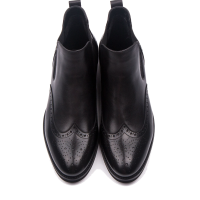Radio network types
The choice of the type of radio network is determined by the available frequency resource, the number of users and the specifics of their work. The most common is the conventional simplex type. It is the conventional simplex type that will be discussed.
Conventional communication is a solution for implementing professional radio communication in a commercial network. The main concept of such a network is to allocate and fix channels for a specific subscriber or group.
Simplex communication - communication in which information is transmitted in only one direction.
Scheme of building a radio network
At present, radio communication equipment is high-tech and allows you to build radio networks of any complexity. From the simplest, "point-to-point", to very complex, "multi-site" using RoIP technologies. Consider several schemes for building a radio network in detail:
- Point-Point;
- Point-MultiPoint;
- Star;
- Single site repeater radio networks;
- Multi-site radio networks with repeaters (IP Site connect, IP Multi-site Connect);
- Multi-site radio networks with relays (using a routing server).

Dot-Dot
Point-to-point is the simplest way to build a radio network.
The main advantage of the radio communication system is its simplicity and low cost. The disadvantages include inefficient use of the frequency spectrum and a small set of service functions. The "Point-to-Point" radio network scheme is most often used to organize technological or service radio communications in limited areas.
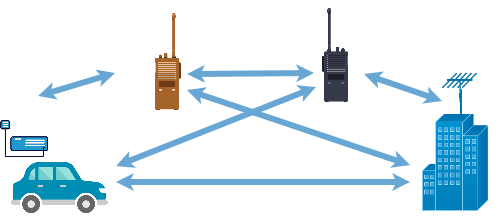
Point-Multipoint
All users hear each other and call the required subscriber by voice. With such a scheme for organizing communication, the number of radio stations, as a rule, is small (from 2 to 20). The radio network can use portable, vehicular, and fixed radios. All of them are equal. Of course, the communication range between automobile (stationary) stations is higher. Such systems are used to provide local communication in a small area. As a rule, this is communication in buildings at a distance of 1-2 km or outside buildings at a distance of 5-10 km.

< /p>
Star
“Star” is a fairly common option when one of the radio stations is a control room. As a rule, a fixed station has a high gain antenna and is located quite high. The communication range with the dispatcher station is large, and subscribers who are not able to communicate directly can send messages through the dispatcher.
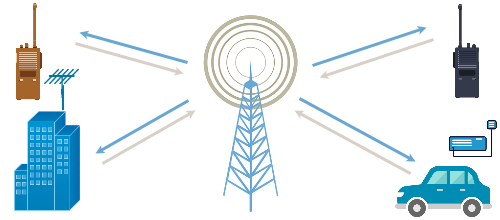 < br>
< br>
Single site repeater radio networks
The scheme for building a radio network using a repeater is more complicated. Repeater systems are used to provide a larger coverage area. Unlike systems with a dispatcher, all radio stations in the entire coverage area can communicate with each other through a repeater. The dispatch radio station can be any of the subscriber radio stations. The repeater does not require daily maintenance, and it can be placed on television and radio relay towers, etc., which can significantly increase the radio range. To work in a radio network using a repeater, two frequencies are required (one for receiving, the other for transmitting) with a separation between the receiving and transmitting frequencies from 600 kHz for VHF and 7.6 MHz - 10 MHz for UHF bands. For the operation of the repeater, two separate antennas can be used for receiving and transmitting, or one, but using a duplex filter. With such a scheme for organizing communication, the dispatcher does not have to be near the dispatching radio station, he can be located anywhere in the coverage area of the repeater and use a regular subscriber radio station as a dispatching station. This solution is the most common and has significant flexibility. This solution is used by almost all major users, large commercial and government agencies, such as the Ministry of Internal Affairs, the Ministry of Emergency Situations, Oblenergo, utilities, etc.
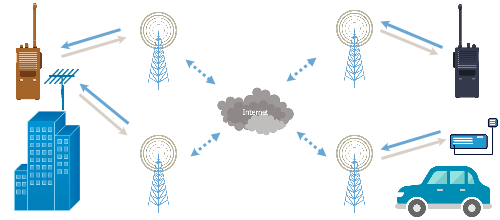
Multi-site radio networks with repeaters (IP Site connect, IP Multi-site Connect)
The use of repeaters installed locally in the same area does not always solve the problem of covering large areas. In such cases, multi-site communication systems are created.
Such an organization can be viewed as a collection of single-site systems united in one common network. One repeater acts as "Master", the rest as "Slave". Combining several sites into a single system allows you to organize coverage of a larger area. Many configurations and degrees of automation of such a combination are possible. One of the most commonly used solutions is based on RoIP technology for transmitting and receiving digital voice audio. RoIP stands for "Radio over Internet Protocol", which means the transmission of a digital voice signal over a digital network channel. A digital network can be either a local area (LAN), a wide area network (WAN) or even the World Wide Web. Thus, using RoIP technology, it becomes possible to carry out voice communications around the world. The disadvantage of this scheme is the connection of a limited number of repeaters (15 repeaters) and poor bandwidth, since all repeaters of the network are either in the receive mode or in the transmit mode. In addition, there is a limit of 200 subscribers per 1 site. This solution is used by almost all major users, large commercial and government agencies, such as the Ministry of Internal Affairs, the Ministry of Emergency Situations, Regional Energy, utilities, etc.
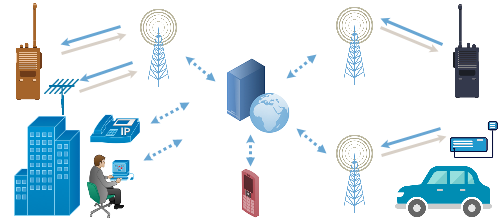
Multi-site radio networks with repeaters (using a routing server)
This scheme is perhaps the most complex and allows you to solve almost all the problems of the radio network. In this scheme, the "Master" is the routing server, and all relays operate in the "Slave" mode. When two subscribers are communicating, for example, the server will put into transmission mode only two repeaters, the first repeater of the calling subscriber and the second repeater in the area of \u200b\u200bwhich the called subscriber is located. The main advantage of this scheme is the connection of an unlimited number of repeaters, high bandwidth, the use of equipment from different manufacturers, the multi-threaded principle of scenario processing. Centralized management of such a communication network can be carried out from one computer. Our company has its own server infrastructure "MicroGIS Smart Route" and provides services for connection and maintenance of subscribers.
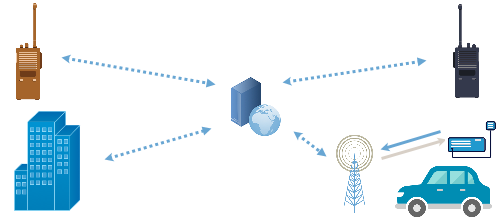
PoC networks (PTT Over Cellular)
PoC network - broadband PTT (Push-to-Talk) network is a technology that uses a broadband cellular network and a broadband WiFi network to build a network and organize communication between subscribers.
This technology is able to provide reliable and secure communication over long distances without deploying a radio infrastructure. As radio stations, as a rule, special GSM subscriber terminals with a PTT button with installed client software are used. The routing server is used as a relay.
Our company has its own server infrastructure "MicroGIS Talk" and provides services for connection and maintenance of subscribers.
This multimedia communications solution is based on a public network (2G, 3G, 4G, Wi-Fi). The solution allows using various types of communication services, including voice, video and data transmission. To use the POC communication service, you only need to install the MicroGIS Talk mobile app on a POC radio, multi-mode smart radio, DVR, or any Android compatible mobile device. Through the public network, you can quickly make individual, group audio and video communications. To communicate in places with poor or no (2G, 3G, 4G, Wi-Fi) coverage, the PoC network is able to work with DMR repeaters, and as subscriber terminals it is necessary to use combined type radio stations that have both DMR and POC buttons PTT.
Main advantages of a POC network:
- 100% coverage and no limits.
- AES-256 traffic encryption ensures security and privacy.
- Professional broadband solution for voice communications (Push-to-Talk).
- Professional broadband video communication solution (Push-to-Talk).
- Professional messaging and data solution.
- Wide range of compatible radios
1 reviews / Write a review
